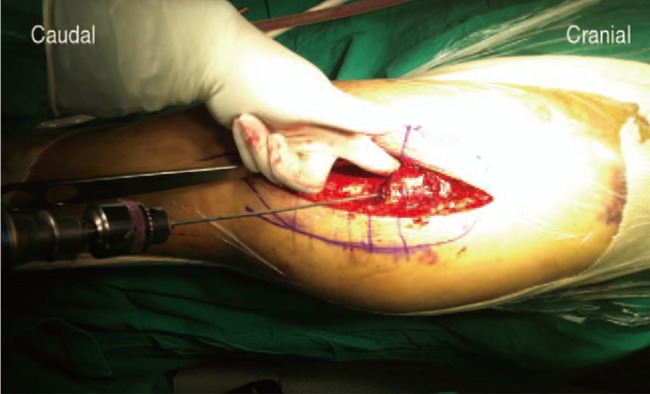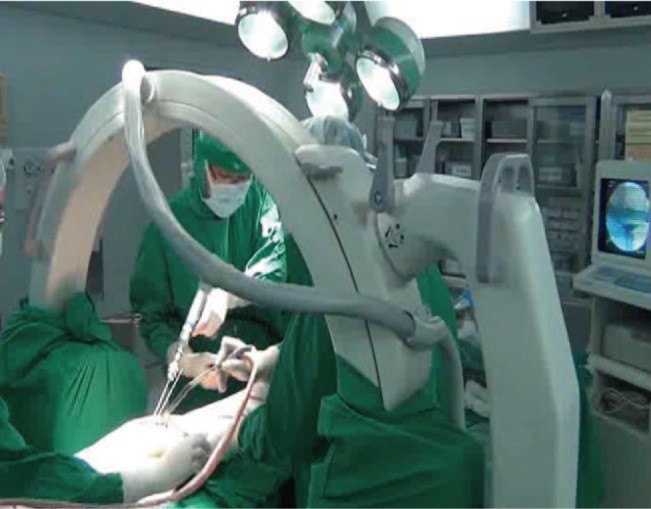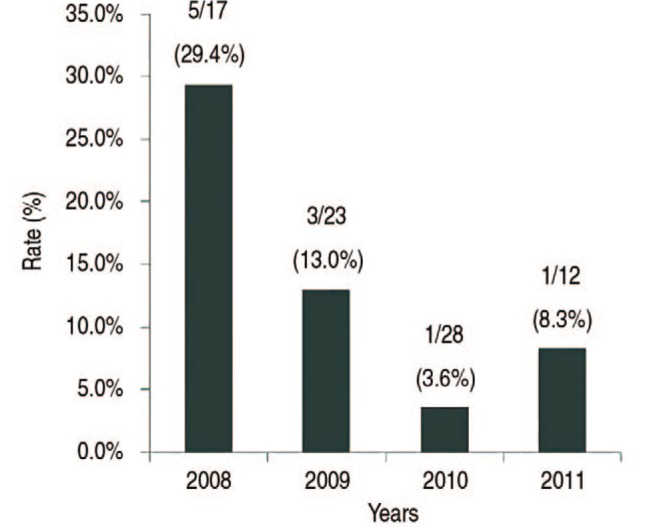Hip Pelvis.
2018 Dec;30(4):254-259. 10.5371/hp.2018.30.4.254.
Outcomes of Internal Fixation with Compression Hip Screws in Lateral Decubitus Position for Treatment of Femoral Intertrochanteric Fractures
- Affiliations
-
- 1Center for Joint Disease, Chonnam National University Hwasun Hospital, Hwasun, Korea. chiasma@hanmail.net
- KMID: 2427929
- DOI: http://doi.org/10.5371/hp.2018.30.4.254
Abstract
- PURPOSE
Internal fixation using compression hip screws (CHS) and traction tables placing patients in the supine position is a gold standard option for treating intertrochanteric fractures; however, at our institution, we approach this treatment with patients in a lateral decubitus position. Here, the results of 100 consecutive elderly (i.e., ≥45 years of age) patients who underwent internal fixation with CHS in lateral decubitus position are analyzed.
MATERIALS AND METHODS
Between March 2009 and May 2011, 100 consecutive elderly patients who underwent internal fixation with CHS for femoral intertrochanteric fracture were retrospectively reviewed. Clinical outcomes (i.e., Koval score, Harris hip score [HHS]) and radiographic outcomes (i.e., bone union time, amount of sliding of lag screw, tip-apex distance [TAD]) were evaluated.
RESULTS
Clinical assessments revealed that the average postoperative Koval score decreased from 1.4 to 2.6 (range, 0-5; P < 0.05); HHS was 85 (range, 72-90); and mean bone union time was 5.0 (range, 2.0-8.2) months. Radiographic assessments revealed that anteroposterior average TAD was 6.95 (range, 1.27-14.63) mm; lateral average TAD was 7.26 (range, 1.20-18.43) mm; total average TAD was 14.21 (range, 2.47-28.66) mm; average lag screw sliding was 4.63 (range, 0-44.81) mm; and average angulation was varus 0.72°(range, −7.6°âˆ’12.7°). There were no cases of screw tip migration or nonunion, however, there were four cases of excessive screw sliding and six cases of varus angulation at more than 5°
CONCLUSION
CHS fixation in lateral decubitus position provides favorable clinical and radiological outcomes. This technique is advisable for regular CHS fixation of intertrochanteric fractures.
Figure
Reference
-
1. Ferrari S, Reginster JY, Brandi ML, et al. Unmet needs and current and future approaches for osteoporotic patients at high risk of hip fracture. Arch Osteoporos. 2016; 11:37. PMID: 27800591.
Article2. Steinberg GG, Desai SS, Kornwitz NA, Sullivan TJ. The intertrochanteric hip fracture. A retrospective analysis. Orthopedics. 1988; 11:265–273. PMID: 3357844.
Article3. Morris AH, Zuckerman JD; AAOS Council of Health Policy and Practice, USA. National Consensus Conference on improving the continuum of care for patients with hip fracture. J Bone Joint Surg Am. 2002; 84-A:670–674. PMID: 11940633.4. Doppelt SH. The sliding compression screw--today's best answer for stabilization of intertrochanteric hip fractures. Orthop Clin North Am. 1980; 11:507–523. PMID: 7413172.
Article5. Halder SC. The Gamma nail for peritrochanteric fractures. J Bone Joint Surg Br. 1992; 74:340–344. PMID: 1587873.
Article6. Larsson S, Elloy M, Hansson LI. Fixation of unstable trochanteric hip fractures. A cadaver study comparing three different devices. Acta Orthop Scand. 1988; 59:658–663. PMID: 3213452.
Article7. Mulholland RC, Gunn DR. Sliding screw plate fixation of intertrochanteric femoral fractures. J Trauma. 1972; 12:581–591. PMID: 5044317.
Article8. Anglen J, Banovetz J. Compartment syndrome in the well leg resulting from fracture-table positioning. Clin Orthop Relat Res. 1994; (301):239–242.
Article9. Brumback RJ, Ellison TS, Molligan H, Molligan DJ, Mahaffey S, Schmidhauser C. Pudendal nerve palsy complicating intramedullary nailing of the femur. J Bone Joint Surg Am. 1992; 74:1450–1455. PMID: 1469004.
Article10. Callanan I, Choudhry V, Smith H. Perineal sloughing as a result of pressure necrosis from the traction post during prolonged bilateral femoral nailing. Injury. 1994; 25:472. PMID: 7960054.
Article11. Evans EM. The treatment of trochanteric fractures of the femur. J Bone Joint Surg Br. 1949; 31B:190–203. PMID: 18150534.
Article12. Orthopaedic Trauma Association Committee for Coding and Classification. Fracture and dislocation compendium. J Orthop Trauma. 1996; 10(Suppl 1):v–ix. 1–154. PMID: 8814583.13. Koval KJ, Skovron ML, Aharonoff GB, Meadows SE, Zuckerman JD. Ambulatory ability after hip fracture. A prospective study in geriatric patients. Clin Orthop Relat Res. 1995; (310):150–159.14. Madsen JE, Naess L, Aune AK, Alho A, Ekeland A, Strømsøe K. Dynamic hip screw with trochanteric stabilizing plate in the treatment of unstable proximal femoral fractures: a comparative study with the Gamma nail and compression hip screw. J Orthop Trauma. 1998; 12:241–248. PMID: 9619458.
Article15. Kyle RF, Cabanela ME, Russell TA, et al. Fractures of the proximal part of the femur. J Bone Joint Surg Am. 1994; 76:924–950.
Article16. Im GI, Shin YW, Song YJ. Potentially unstable intertrochanteric fractures. J Orthop Trauma. 2005; 19:5–9. PMID: 15668577.
Article17. Palm H, Jacobsen S, Sonne-Holm S, Gebuhr P. Integrity of the lateral femoral wall in intertrochanteric hip fractures: an important predictor of a reoperation. J Bone Joint Surg Am. 2007; 89:470–475. PMID: 17332094.18. Hardy DC, Descamps PY, Krallis P, et al. Use of an intramedullary hip-screw compared with a compression hipscrew with a plate for intertrochanteric femoral fractures. A prospective, randomized study of one hundred patients. J Bone Joint Surg Am. 1998; 80:618–630. PMID: 9611022.
Article19. Baumgaertner MR, Curtin SL, Lindskog DM. Intramedullary versus extramedullary fixation for the treatment of intertrochanteric hip fractures. Clin Orthop Relat Res. 1998; (348):87–94. PMID: 9553538.
Article20. Lee KH, Jeong H, Ha JK, Kim YJ, Jang WH. Lateral positioning for proximal femoral nailing of the intertrochanteric fracture: surgical technique. J Korean Fract Soc. 2011; 24:79–82.21. Sonmez MM, Camur S, Erturer E, Ugurlar M, Kara A, Ozturk I. Strategies for proximal femoral nailing of unstable intertrochanteric fractures: lateral decubitus position or traction table. J Am Acad Orthop Surg. 2017; 25:e37–e44. PMID: 28134676.22. Baumgaertner MR, Curtin SL, Lindskog DM, Keggi JM. The value of the tip-apex distance in predicting failure of fixation of peritrochanteric fractures of the hip. J Bone Joint Surg Am. 1995; 77:1058–1064. PMID: 7608228.
Article23. Sedighi A, Sales JG, Alavi S. The prognostic value of tipto-apex distance (TAD index) in intertrochanteric fractures fixed by dynamic hip screw. Orthop Rev (Pavia). 2012; 4:e32. PMID: 23589760.
Article24. Fang C, Lau TW, Wong TM, Lee HL, Leung F. Sliding hip screw versus sliding helical blade for intertrochanteric fractures: a propensity score-matched case control study. Bone Joint J. 2015; 97-B:398–404. PMID: 25737525.
- Full Text Links
- Actions
-
Cited
- CITED
-
- Close
- Share
- Similar articles
-
- A Clinical Study of Intertrochanteric Fractures
- The Radiographic Analysis of Unstable Intertrochanteric Fractures Treated with Compression Hip Screw
- Proximal Femoral Shortening after Operation with Compression Hip Screws for Intertrochanteric Fracture in Patients under the Age of 60 Years
- Fixation Failure after internal Fixation in Intertrochanteric Fractures
- Analysis of the Causes for Failed Compression Hip Screws in Femoral Intertrochanteric Fracture and Hip Reconstruction Operation




